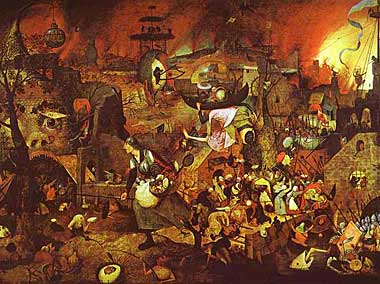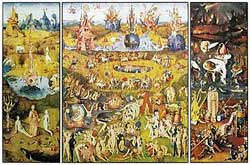| |
|
|
|
|
| |
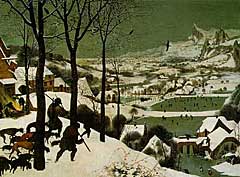
Pieter Bruegel The Elder
The Hunters in the Snow (January)
1565, Kunsthistorisches Museum, Vienna
Although Bruegel was famous in his own lifetime, the archaic appearance of much of his imagery and his disinclination to adopt the idealized style of portraiture developed by the Italian Renaissance artists had, at least in sophisticated circles, an adverse effect on his reputation both during his lifetime and after his death. Since his works did not conform to the aesthetic theories of the time, the early art historians were inclined to disregard him and indeed there appears to have been little serious academic study of his work until the 20th century. Furthermore there are no extant records of his thoughts on art and no letters by his hand survive. The result is therefore an absence of significant detail concerning much of his life... learn more |
|
Pavel Nikolaevich Filonov (1883-1941)
A Peasant Family (The Holy Family)
1914. Oil on canvas, 159x128 cm
The Russian Museum, St.Petersburg
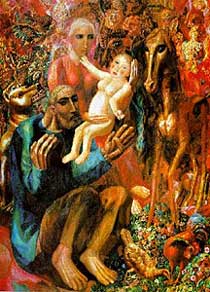
Pavel Filonov was born in Moscow. Early orphaned, he moved to St. Petersburg where he took art lessons. From 1908 to 1910 he attended the Academy of Arts, but was expelled in 1910. In 1911 he came in contact with the Union of Youth and contributed to its exhibitions. Next year travelled to Italy and France. In 1913 designed the stage set for Vladimir Maiakovskii's tragedy Vladimir Maiakovskii. Over the next two years he worked as an illustrator of futurist booklets, published his transrational poem The Chant of Universal Flowering (Propoved' o porosli mirovoi), and started developing his artistic theories, the so-called Ideology of Analytical Art and the Principle of Madeness... learn more |
|
| |
|
|
|
|
| |
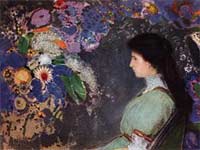
'Symbolist' painter, graphic artist, and printmaker, Bertrand Jean Redon or Odilon Redon, was born on April 20, 1840 in Bordeaux, France. He was born in the wealthy family of Bertrand Redon, a French colonist, and Marie Guerin. Odilon spent his early childhood at his uncle's estate in Peyrelebade. In 1880, he married Camille Falte, who later on acted as his spokesperson, dealing with the media and the buyers of his works... learn more
|
|
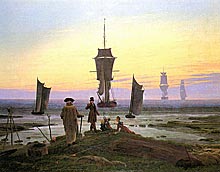
Nineteenth century, German 'Romantic' landscape painter, Caspar David Friedrich was born on September 5, 1774, in Greifswald, to candle-maker, Adolf Gottlieb Friedrich and Sophie Dorothea Bechly. By the age of thirteen, Caspar had lost his mother, sister, and brother... learn more |
|
| |
|
|
|
|
|
ARTISTS |
|
| |
Giotto di Bondone (Italian, 1267-1337)
First great pre-Renaissance fresco painter (Scrovegni Chapel Padua).
Jan van Eyck (Dutch, 1390-1441)
Finest pioneer oil painter, noted for his realistic portrait masterpieces.
Roger Van der Weyden (1400-1464)
Dutch artist and leading religious panel-painter of Northern Renaissance.
Piero della Francesca (Italian, 1420-92)
Italian Renaissance painter, pioneered the rules of linear perspective.
Andrea Mantegna (1430-1506)
Renaissance master, pictures noted for mastery of perspective and detail.
Alessandro Botticelli (1445-1510)
Florentine Renaissance master, creator of La Primavera.
Hieronymus Bosch (Dutch, 1450-1516)
Greatest of all medieval painters, noted for complex moralizing works.
Leonardo da Vinci (Italian, 1452-1519)
Greatest Renaissance oil painter/draftsman (the Last Supper, Mona Lisa).
Albrecht Durer (German, 1471-1528)
Greatest painter and printmaker of the Northern Renaissance.
Lucas Cranach the Elder (German, 1472-1553)
Leading Renaissance painter in Germany, noted for his court portraiture.
Michelangelo Buonarroti (Italian, 1475-1564)
Greatest Renaissance sculptor (Pieta, David) and painter, renowned for his Genesis and Last Judgement frescoes in the Sistine Chapel in Rome.
Titian (Italian, c.1477-1576)
Greatest Renaissance exponent of colour in oils and fresco.
Raphael (Italian, 1483-1520)
"Il Divino", greatest Renaissance painting prodigy (School of Athens).
Hans Holbein The Younger ( German, 1497-1543)
Celebrated as one of the greatest portrait painters.
Jacopo Tintoretto (Italian, 1518-1594)
Major Venetian painter of monumental religious works.
Pieter Bruegel the Elder (Flemish, c.1525-1569)
Leading Flemish artist of his day, master landscape painter.
Paolo Veronese (Italian, c.1528–1588)
El Greco (Domenikos Theotocopoulos) (Greek, 1541-1614)
Noted for his dazzling spiritual works and portraits.
Caravaggio (Italian, 1573-1610)
Milan virtuoso noted for his imaginative, sensational Biblical paintings.
Peter Paul Rubens (Flemish, 1577-1640)
Foremost Baroque history painter and portraitist.
Frans Snyders (Flemish, 1579-1657)
Flemish still life painter
Frans Hals (Dutch, 1580–1666)
Undisputed master of Baroque still life.
Nicolas Poussin (French, 1594-1665)
Possibly the greatest classical academic painter of all time.
Francisco de Zurbaran (Spanish, 1598-1664)
Master of chiaroscuro, noted for his religious pictures and still-lifes.
Anthony Van Dyck (Flemish, 1599-1641)
Infant prodigy, pupil of Rubens, noted for his portraits.
Diego Velazquez (Spanish, 1599-1660)
Court painter, possibly the greatest Spanish old master.
Rembrandt van Rijn (Dutch, 1606-1669)
Finest exponent of chiaroscuro in narrative and portrait painting.
Jan Vermeer (Dutch, 1632-1675)
The greatest Dutch genre-painter, unrecognized in his life time.
Giovanni Battista Tiepolo (Italian, 1691–1770)
Jean Chardin (French, 1699-1779)
One of the greatest 18th century still life artists.
Joshua Reynolds (English, 1723–1792)
English landscape master.
Francisco Goya (Spanish, 1746-1828)
Spanish court painter, one of the great portraitists (The Nude Maja).
Jacques-Louis David (French, 1748-1825)
Passionate, classical-style, political master painter.
Caspar David Friedrich (German, 1774 – 1840, Romantic Landscape Painter)
|
|
| |
|
|
|

